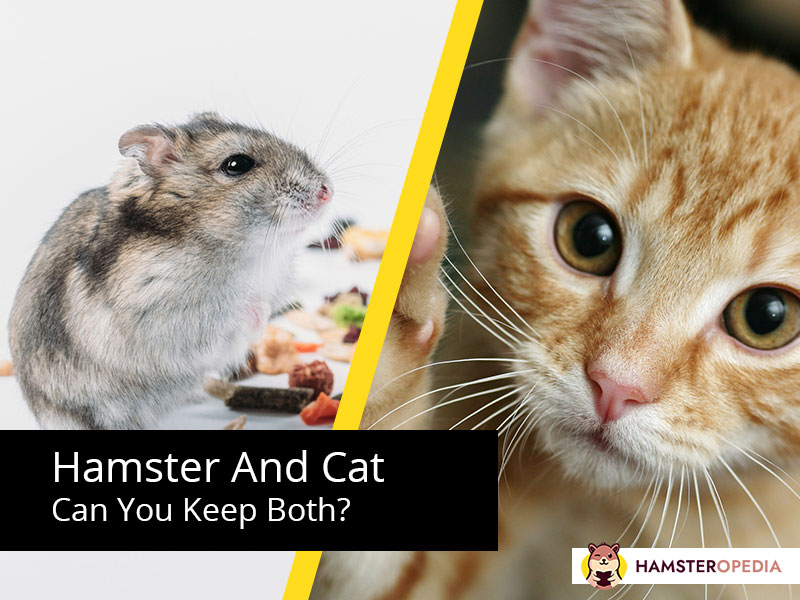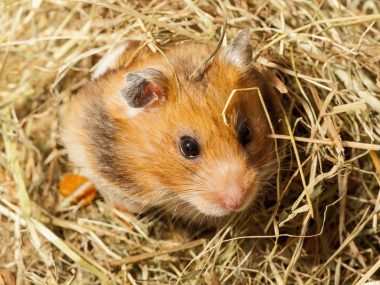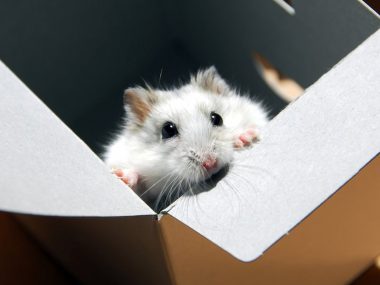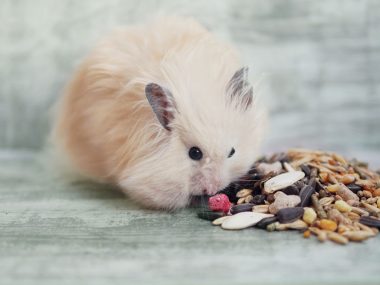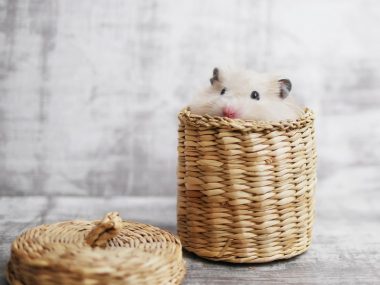Zoos keep lions and antelope, but the secret is that they don’t ever keep them together. The result would be catastrophic for the prey animals. This is the same tactic you will need to use if you own a cat and a hamster. That means keeping your hamster safe in a household with a cat will be challenging.
You can keep a cat and a hamster if they are kept apart. The hamster must stay in a separate room. Cats can hear ultrasonic hamster sounds and will hone in on a hamster. Cats instinctively pursue small rodents. The hamster will also be able to hear and smell the cat which will cause stress.
The rules between predators and prey were drawn up long ago. As innocent and adorable as your lazy housecat may appear, she knows she is a predator, and a tiny hamster is a perfect prey animal.
Table of Contents
Can I Keep A Cat And A Hamster?
It is possible to keep a cat and a hamster, but only if you are prepared to be a full-time bodyguard for the hamster. Your hamster would need to be treated like a Hollywood VIP on the red carpet and be completely physically out of bounds to the cat at all times.
There are a few reasons why it is tricky to keep a hamster and a cat together in the same household:
- In nature, hamsters are prey animals which means they are food for predators like cats.
- Cats are natural predators of small mammals, including hamsters. In some national parks, domestic cats are specifically listed as a threat to wildlife.
- Hamsters are defenseless against cats.
- Cats are curious and, by nature, want to investigate everything.
- Cats are incredibly agile. They are excellent jumpers and climbers, so keeping a hamster cage entirely out of a cat’s reach is difficult.
- You won’t be able to hide the presence of a hamster from your cat. Hamster hearing is superb, but cat hearing is ultra-refined specifically to hear high-frequency sounds emitted by hamsters. There is a whole array of sounds taking place that humans are unaware of. A cat will be acutely aware of a rodent’s presence, even if it can’t see it.
- Cats and hamsters carry particular scents. Even if your kitty is super well-behaved and doesn’t try to get into your hammie’s cage, the hamster is highly tuned into the presence of a predator nearby.
- Both the cat and the hamster are nocturnal. So while you are asleep at night, the hunter and the prey animal move into top gear. Your hamster will start spinning on its wheel and moving around, searching for food. A cat’s eyes are adapted to see well in low light, and along with super sensitive hearing, it will be attracted to the action in the hamster cage.
- Stress is a major cause of premature death in hamsters. Your cat may be able to scare the hamster to death even if it cannot touch it.
Do Cats Harm Hamsters?
It is a cat’s instinct to hunt. Most kitty play toys involve some sort of toy lure for the cat to pursue. Even a well-fed house cat will harm a hamster – they don’t mean harm, but since they are hotwired to hunt to survive, they will chase anything small that moves.
There are two ways that a cat may harm a hamster:
- Physically – If the cat can reach the hamster, things will not end well for the little rodent. Cats must never be trusted around hamsters. Even if they don’t actually eat the small pet, they are likely to kill it for sport.
- Indirectly – Hamsters are pretty highly strung even if it is in a cat-proof cage setup. A hamster may stress having a predator in the vicinity. Stress in hamsters can lead to conditions like wet tail or anxiety-related behavioral problems like cage chewing, which can be fatal.
How Do I Protect My Hamster From My Cat?
Keeping your hamster safe from your cat is a lot about checking and double-checking. You have to create a mini hamster Alcatraz that your cat can’t get into and the hamster can’t escape from. To keep the hamster safe from a cat, you must institute various security levels so that even if one fails, another will save the day.
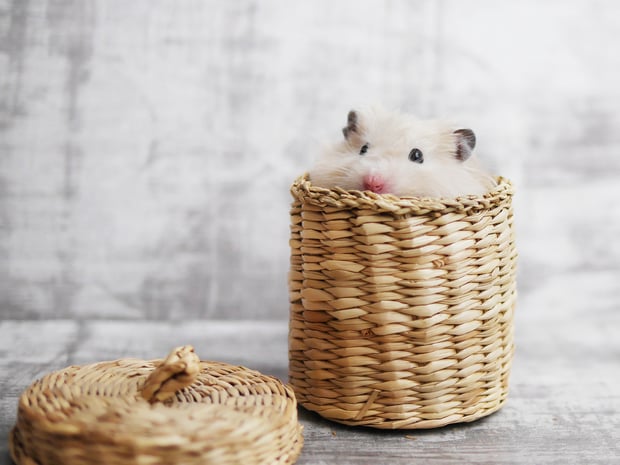
- Keep the hamster in a separate room from the cat. A hamster doesn’t mind being kept in a quiet room or study area. Find a comfortable spot where your hamster cage will be safe from any feline investigation.
- Invest in the right sort of sturdy cage – all hinges and openings must lock together tightly, so it will stay together even if it is pushed over. Ensure that the top lid can’t be lifted off by a wily cat. The best option for a cat-proof cage is to use a plastic cage or glass aquarium so the cat can’t get its claws between the bars.
- Place the hamster cage in a place where it is least likely to be pushed or pulled down. A corner is a good option since two sides are naturally protected.
- Have plenty of hamster hideouts and deep bedding, so the hamster can bury itself quickly if it feels scared and be out of view of the cat.
- Only interact with your hamster when your cat is out of the room. Playtime and hamster cage cleaning time must be a quiet time you spend alone with your hamster.
Things To Avoid If You Have A Hamster And A Cat
There is loads of conflicting information about how to handle hamsters and cats in the same home. Since hamsters are entirely vulnerable to cats, owners must prioritize their health and safety.
Tips to keep your hamster safe:
- Never keep the hamster cage inside a closed cupboard to keep it away from a cat. It is too dark, stuffy, and cold. Although hamsters sleep a lot during the day, they must live in a healthy, well-ventilated environment.
- Do not expect to train your cat to leave the hamster alone. It is a cat’s instinct to catch small rodents. A cat may obey you while you are in the room supervising, but it must never be trusted alone with a tiny prey animal.
- Do not put your hamster in a plastic hamster ball to protect it from a cat. Plastic hamster balls are uncomfortable, unhealthy, and unhygienic for hamsters. Having a cat spinning the ball around would be stressful and cruel.
- When playing with your hamster, seal the room so the small creature can’t slip out into the cat zone. Be sure to put a towel under the door. A safe way to play with your hamster is to create a playground in an empty bathtub (be sure to put the plug in). Then you can enjoy your hamster and let it explore some mazes and run all over you without stressing that it will get away.
Can A Cat And A Hamster Be Friends?
There are heartwarming accounts of animals that have crossed the boundaries of their species and formed unlikely friendships. While your cat might be on its best behavior and restrain itself while it is being supervised, leaving it unsupervised with a hamster is never advisable.
While a cat may be peaceful towards the hamster, the little hamster is most likely still getting predator vibes from the cat, which would be highly stressful. Once in a while, you may find a confident and chilled hamster, but for safety’s sake, it is better if the hamster and the cat are friends with their owner and not with each other.
Will My Cat Eat My Hamster?
A well-fed house cat may not actually consume a hamster, but it is highly likely to antagonize it to death. Playing with a small, moving rodent is an instinct for a cat. Once the hamster stops moving, the game will end, and the cat may eat small pieces of the rodent, but they often lose interest.
Cat owners must remember that for cats, killing small rodents is an essential part of their personality. They are not being mean or trying to upset you by going after the hamster – it is what they are programmed to do. Evidence indicates that cats were domesticated and prized precisely because of their rodent hunting skills.
If you have a hamster and a cat in the same house, the best way to protect the hamster is to keep it in an entirely separate room behind a closed door. As an added security measure, keep the hamster in a cat-proof cage.
So, Can I Keep A Cat And A Hamster?
Cats and hamsters will never be good friends, and you may never get any complete family photographs if you keep both pets. Cats naturally hunt small rodents; unfortunately, a hamster ticks all the boxes on a cat’s prey list. If you own a hamster and a cat, the rodent must be kept behind closed doors in a cat-free room.
